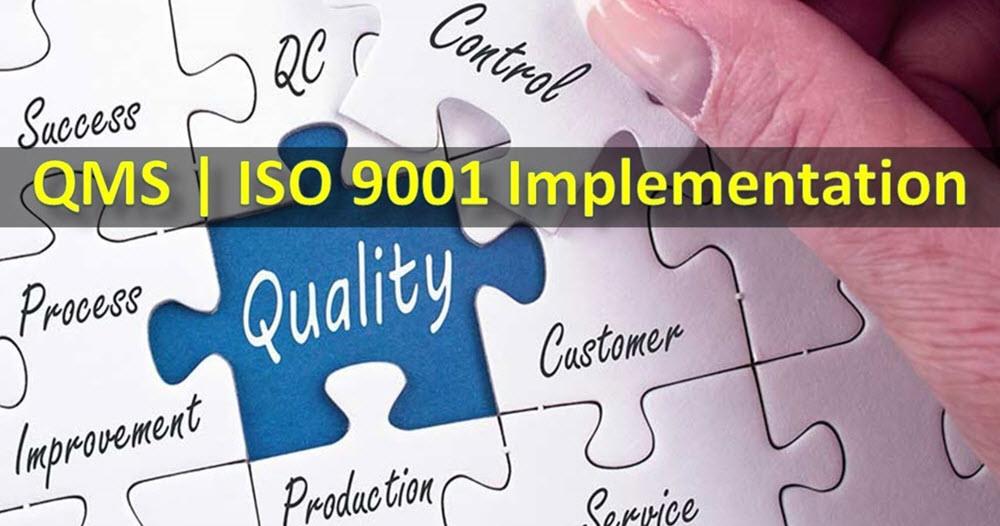EQMS Blog

ISO 9001 Implementation Steps For Quality Management Systems
The ISO 9001 family of quality management system standards is designed to help and ensure an organisation meet the need of their customers and also their stake holders while complying with regulatory requirements related to their products or services. During development and implementation of a quality management system it can often be an advantage to use ISO 9001 Consultants.
Let’s continue with outlining the ISO 9001 implementation steps.
ISO 9001 Implementation Steps
Implementation Step 01 – Establishing an Implementation Team
The first of the ISO 9001 implementation steps is establishing a required team of individuals who are well aware of the quality management system. A team should be headed by the service provider and management representative. Prior to applying the ISO 9001 implementation steps, the service provider and management representative are responsible of planning and overseeing the quality management system.
Implementation Step 02 – Conducting Awareness Program
Informing your employees about the quality management system is very important. Thus, you need to conduct an awareness program where you will inform your employees about the importance and aim of the quality management system. This also includes the advantages it offer the customers and employees as well as the staffs roles and responsibilities within the system.
Implementation Step 03 – Conducting Initial Status Survey
A quality management system should be created confirming the ISO 9001 standards. Now, this step does not prevent incorporating, adapting or adding onto the quality program that has been implemented previously. However, this ISO 9001 implementation step basically compares the existing quality management program (if there is any) with the standards of ISO 9001.
Implementation Step 04 – Creating a Documented Implementation
A documented plan is used to address any non-compliance after the organisation’s quality management system has been compared with the ISO 9001 standards. The documents implementation plan identifies the process and makes the organisation’s quality management system fully compliant with the ISO 9001 standard.
Implementation Step 05 – Developing Quality Management System Documentation
Where the noncompliance’s regarding quality management systems are very common is the area of documentation. In order to avoid these nonconformities, following should be developed.
- Documented statements of a quality policy and quality objectives.
- Documented processes and records required by the ISO 9001 standard.
- Documents needed to ensure effective planning, operation and control of its processes.
Implementation Step 06 – Control of Documents
A documented system should be created to control documentation required as part of the quality management system. The document control system should cover every type of documentation used as part of the QMS and meet the criteria of the ISO 9001 standard.
Implementation Step 07 – Implementation
This element of the ISO 9001 implantation steps evolves around the implementation of the quality management system. In large organisations it would be best to implement the quality management system in steps as it is being documented and developed. In small organisations, it is okay to implement the quality management system all at once. In the next phase an evaluation should be taken to oversee the effectiveness of the quality management system.
Implementation Step 08 – Internal Quality Audit
To check the effectiveness of the quality management system, it should be check by the quality assurance or the internal audit team. Below are the reasons for conducting internal audits.
- To ensure that the quality management system conforms to the requirements of the quality management system which have been established by your organisation, as well as to the requirements of the ISO 9001 standard.
- To ensure that the quality management system is implemented and maintained in an effective manner.
- To drive continuous improvement within your quality management system.
Implementation Step 09 – Reviewing by Management
After the implementation of the quality management system, management reviews should be conducted at planned intervals. There are no required frequency, however many organisation conduct management reviews minimum once a year. This is to review the continuous effectiveness of the system.
Implementation Step 10 – Certification and Registration
A formal application as a certificate is made by the certification body after 3-6 months of ISO 9001 implementation and stabilisation. A certification body only issues the certificate when the quality management system meets the requirement of the ISO 9001 standard. The certificate is valid for 3 years and surveillance audits will be conducted during that period.
Implementation Step 11 – Continual Improvement
After gaining a certificate from the certification body, the organization should focus on the continues effectiveness and the stabilization of the quality management system to meet the needs of their customers and enhance their satisfaction.
This guideline gives a good overview of the steps to take when implementing your ISO 9001 compliant quality management system. If you are looking for professional support with your implementation we are more than happy to help. Please contact us for free quote on your project.

Request a free consultation
Contact us to discuss your needs and see how we can support to reach your goal.

Recent posts

In today's digital age, businesses are constantly exposed to various cyber threats. As a result, companies must adopt a proactive approach to cybersecurity to prevent data breaches, theft, and other...

Quality management systems are essential in ensuring that organisations can deliver quality products and services consistently. The International Organisation for Standardization (ISO) developed the ISO 9001 standard to help organisations...

ISO 14001 is a globally recognised standard for environmental management systems (EMS) that helps organisations manage their environmental impact and improve their sustainability performance. Obtaining this certification demonstrates a company's...
Just a Few of Our Clients
Request a Free Consultation
Contact us to discuss your needs and see how we can support to reach your goal.












